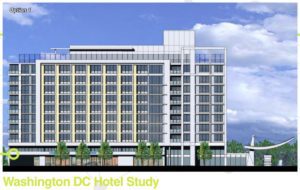In recent weeks, travel restrictions and physical distancing efforts around the world have become more widespread, causing hotel properties across the nation to experience significant drops in demand of an uncertain duration. Generally speaking, hotels and motels have closed their operations since the COVID-19 pandemic took hold.
 While everyone wants a world in which hotel businesses survive and thrive, one question that is being asked is: how many hotel and motel facilities will survive the pandemic and how many will need to close their doors permanently? As with any economic downturn, an external shock like this pandemic is likely to spur businesses to take actions that might normally have been pursued in a more gradual manner.
While everyone wants a world in which hotel businesses survive and thrive, one question that is being asked is: how many hotel and motel facilities will survive the pandemic and how many will need to close their doors permanently? As with any economic downturn, an external shock like this pandemic is likely to spur businesses to take actions that might normally have been pursued in a more gradual manner.
For those hotel properties that are unable to reopen after the COVID-19 crisis is over, there may be an opportunity to address another national crisis: Affordable Housing. Might this be a moment to consider turning hotel space into much needed affordable housing?
Hotel rooms and suites are essentially studio apartments that contain all the living accommodations people need except for kitchens. With minimal effort, compared to new construction, hotels could be converted to accommodate longer-term living. With this basic premise, could the hotel industry make proverbial “lemonade” from the COVID-19 “lemon” and be a source of much needed affordable housing?
Expert Panel: Insights on Adaptive Reuse of Hotels into Affordable Housing
At Wells + Associates, we regularly speak with developers, architects, land use attorneys, and other real estate professionals about the future of transportation, land use, and real estate. Based on recent conversations, we sense that the “new normal” which emerges after the coronavirus pandemic may accelerate efforts to reexamine development patterns and transportation systems across the country.
People across the industry have been asking for our take on the current state of the world and where we might be going. While we have our opinions and perspectives, we feel the best insights in this uncertain environment come from real estate entrepreneurs and veterans, who—day in and day out—help the field respond to the demands of the day.
As we move through this pandemic together, we believe it is a good time to share ruminations from an array of experts regarding what the future may hold for hotels and whether the pandemic may present an opportunity to address a challenge which predates COVID-19: the nation’s affordable housing crisis.
- Policy: Maya Brennan, Urban Institute
- Finance: John Coe, Coe Enterprises
- Legal + Zoning: G. Evan Pritchard, Esq., Venable
- Affordable Housing Development: Shelley Murphy, Wesley Housing
- Design + Amenities: Douglas N. Carter, AIA, DCS Design
- Civil/Site Design: David B. Logan, P.E., Bohler
- Traffic + Parking Supply: Michael J. Workosky, Wells + Associates
- Traffic + Parking Demand: Justin B. Schor, Wells + Associates
Policy

Maya Brennan, Senior Policy Program Manager, Urban Institute
“Even before the pandemic led to widespread unemployment filings and income loss, communities across the US had a shortage of lower-cost rental housing. Imbalanced housing markets harm communities, impede residents’ wellbeing, and hinder economic development. As state and local governments look for effective strategies to protect residents, produce more housing across the income spectrum, and preserve existing affordability, adaptive reuse of existing structures can play a key role.
Whether in areas that attracted business or recreation travelers, converting underutilized hotels into multifamily housing could support a strong and inclusive housing supply and bring low- and moderate-income households closer to job centers. According to the Joint Center for Housing Studies of Harvard University, more than half of US renter households earning between $30,000 and $45,000 per year spend too much on their rent. Even among renters earning $45,000 to $75,000 per year, more than one in four has a rental cost burden. Repurposed hotels may offer an affordable and appealing solution for smaller households in these income bands.”
Finance

John Coe, Principal, Coe Enterprises
“To review the opportunity to retrofit existing hotel buildings that are currently either operating unprofitably and seeking an alternative use or not currently operating into affordable rental housing, there are several financial considerations for owner/developers to consider:
- Is the existing hotel property currently encumbered by debt? If so, the current or new owner will need to recapitalize the loan with an interim construction facility to pay off the existing loan and provide the hard and soft construction costs after scoping out and underwriting the opportunity
- Depending on the affordability levels of the proposed redeveloped project, the source of the construction facility could vary considerably. Here are a couple alternative sources:
- Assuming the owner/developer is a “for-profit” entity and the project is offering at least 40% of the proposed units for tenants who qualify with incomes below 60% of Average Median Income in the Metro Area, the project could qualify for Low Income Housing Tax Credit (LIHTC) financing where equity investors are corporations seeking tax credits and the debt financing is provided usually by state government finance agencies
- For “non-profit” ownership entities and for-profit owners that seek “deeply” affordable unit financing options, HUD in combination with local finance agencies provides a multi-level capital stack of first and subordinate debt financing together with equity subsidies in various forms, including LIHTC, as mentioned above.
- Usually, the forms of financing mentioned above are a combination of construction and permanent financing, such that upon completion and lease up of the retrofit property, the construction loan automatically converts to a permanent loan.
- Both of the alternative financing structures cited above are often highly competitive to obtain, as demand for this capital always exceeds its supply in most urban markets where the need is great for affordable housing.
If the existing property offers unique locational advantages (offering affordable housing in areas that have extraordinary demand), lenders and local housing finance agencies will prioritize these projects, particularly if well-conceived and sponsored by experienced housing operators or non-profits with political influence and housing construction and operational capabilities.”
Legal + Zoning

G. Evan Pritchard, Esq., Counsel, Venable
“Except in situations where a use conversion could be accomplished as a matter of right under applicable zoning ordinance requirements, a change in use from hotel to affordable housing would require zoning approval from the local governing body. Many approved hotels were built subject to proffers or development conditions that regulate things like the maximum number of rooms, minimum parking requirements, shuttle services to local transit facilities, and guest amenities such as in-hotel bars and restaurants, among others. All of these elements, and their corresponding impact on the neighboring community, would have to be reevaluated as part of a zoning amendment.
In considering a change in use, the governing body would look to its comprehensive plan for guidance. In some instances, the comprehensive plan guidance might be broad enough to allow for residential use in place of or in addition to hotel use. In other cases, the comprehensive plan might only envision hotel or other commercial uses for a given property, in light of the fact that hotels have different impacts on surrounding transportation systems and other community services like libraries, police departments, and schools. In those instances, an amendment to the comprehensive plan might be needed in addition to the underlying zoning change approval.
Another issue for consideration is how local building codes treat hotels and residential buildings differently. In particular, there are different standards applied in terms of fire safety signage and equipment, depending on the nature of the use. These factors would also have to be considered as part of any potential use change.”
Affordable Housing Development

Shelley Murphy, President/CEO, Wesley Housing
“In some jurisdictions, motels have been used to house the homeless when there isn’t enough shelter space. In the COVID-19 environment, empty hotels are being used for families that would normally be in shelters as a way of creating greater social distancing. While no one knows what the market will look like in our “new normal” it is likely that there may be a surplus of hotel/motel capacity, which may make them good candidates for redevelopment as housing. Because of the small room sizes, some could be used for supportive housing or individuals coming out of homelessness in a “single room occupancy” (SRO) model.
The conversion to a full blown apartment with a kitchen (we call it “adaptive reuse”) would have to be looked at on a case-by-case basis, but is likely to be expensive. Depending on the amenity space built out in the hotel, it might actually work better as market rate housing. Adaptive reuse of office buildings is something that has been going on for a while now, but in most instances it is redeveloped as either market rate condos or market rate apartments.”
Design + Amenities

Douglas N. Carter, AIA, Founding Principal, DCS Design
“Hotel to residential conversions are much more easily accomplished that office to residential for a number of reasons. First, the massing of hotels, especially in terms their widths, is much closer to the norm for residential than is office. Secondly, the exterior column to column module is very close to residential practice so that two rooms convert well to a one-bedroom apartment and three rooms to a two-bedroom. Hotel rooms are shallower than residential units resulting in better daylighting throughout the space. Because hotels are usually rectangular, unit layouts can be very repetitive reducing construction costs. Many hotels will have a number of amenities such as pools and fitness centers already in place with enough back of house space for additional amenities, mailrooms, leasing areas, etc. This can be especially relevant if the end product is to be independent or assisted living. One last consideration, many older hotels are taller than what would currently be allowed which is another argument for retaining an existing structure.

Building systems in hotels are also conducive to conversion. The elevator requirements for hotels are closer to residential practice, resulting in little or no excess capacity as there can be with an office to residential conversion. Plumbing stacks are in place although not necessarily in the preferred locations but that can be addressed easily enough. If the interior is being gutted then the shell is a good candidate for pre-fabricated kitchens and baths. The typical through wall HVAC unit will have to be scrapped but VRF systems are almost perfect for this sort of retrofit. Given the differential in parking ratios that can exist between hotels and residential, there may be opportunities for adding density with no additional parking requirements.”
Civil/Site Design

David B. Logan, P.E., Principal, Bohler
“Depending on the previous proffers and development conditions, certain stormwater and landscape elements may need to meet current code requirements. Working closely with the land use attorney and traffic engineer, the parking requirements may also require revisions to the site layout. Addition of impervious area, such as asphalt and sidewalks, may necessitate creative stormwater management considerations. Conversely, removal of impervious area may create opportunities for landscaping and other resident amenities.
Other “green” policies may also apply. In the District of Columbia, for example, the construction cost compared to the Assessed Value of the existing improvements may require certain Green Area Ratio improvements to the site. Assessing these impacts to the site layout in the due diligence stages can help build momentum for the most expeditious path to a successful project.”
Traffic + Parking Supply

Michael J. Workosky, President, Wells + Associates
“The consideration for converting hotel to affordable housing can have a positive impact on the transportation network. This is not a guarantee and some consideration should be given to both the vehicle trip generation and parking during this effort. The Institute of Transportation Engineers (ITE), the guiding organization for trip generation, suggests that multifamily uses would generate fewer vehicle trips during the course of a day and during the peak hours. When comparing the same number of hotel rooms to apartment units, approximately 40% to 50% fewer trips throughout the day can be expected. The reduction is likely even greater as the project may have to reduce the number of units as compared to the number of hotel rooms. This is great news when considering that traffic impact often becomes the biggest point of contention when discussing new residential projects.
A closer look needs to be given to parking. The zoning codes of the local jurisdictions provide guidance on parking rates. A considerable number of jurisdictions suggest that a hotel should provide one (1) space per room while apartments should provide closer to 1.6 spaces per unit. This represents an increased need for parking over what the hotel was likely providing. If providing additional parking is not feasible, some creative solutions will have to be considered. This may come in the form of a reduced unit count, which may already be on the table, or additional TDM measures to justify a modified parking rate. It will be important to take a good look at the local jurisdiction’s parking rates, opportunities for parking reductions, access to transit and amenities, and parking management strategies as early in the process as possible to understand what a reasonable unit count can be for the project.”
Traffic + Parking Demand
Justin B. Schor, Vice President, Wells + Associates

“From the perspective of influencing travel behavior change to reduce the impact of traffic and parking, multi-family housing is much easier to work with. Although hotels do have employees who have regular commute patterns, they represent a small percentage of the traffic and parking demand at a hotel. It’s the hotel guests who are the biggest contributors to traffic and parking, but those guests (and where they come from or go to) change from day to day. That makes it difficult to communicate with them in advance about changing their travel behavior from driving a car to some other form of transportation.
On the other hand, tenants in multi-family housing live there on a longer-term basis and tend to have predictable commuter patterns for us to work with. We work with tenants (or even prospective tenants) to identify where they work and how they can get there without driving alone. Our goal is to help them see that they can be car-free (or at least car-light) and still get to the places they want to go in the communities we serve.”

